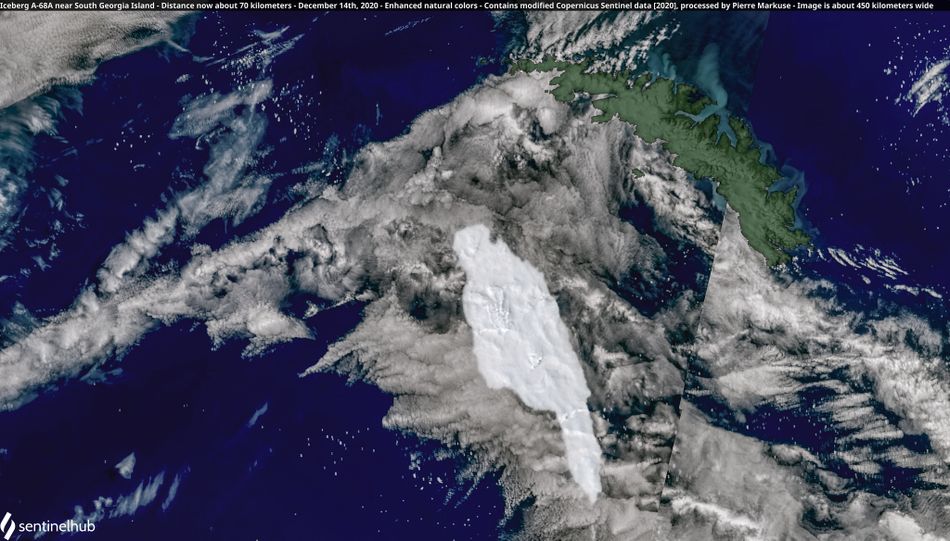Meet the most suspenseful berg on Earth.
Enormous iceberg A-68a, which at some 1,500 square miles is currently larger than Rhode Island, has captured the attention of Antarctic and earth science researchers. For over a month, it’s gradually approached South Georgia Island in the remote Southern Atlantic Ocean. Now, the berg is flirting with grounding, and potentially getting stuck, off the island. The event is a big curiosity: It’s unknown what the great berg will ultimately do and how it might impact life on and around the biologically-rich, penguin-populated island.
“It’s a fascinating berg, given the size and trajectory,” said Stef Lhermitte, an assistant professor in the Department of Geoscience and Remote Sensing at Delft University of Technology, in the Netherlands.
By just glancing at one of many recent images, it may look like A-68a is on an imminent collision course with similarly-sized South Georgia Island. But that’s deceiving.
The iceberg is now rotating clockwise as surface currents push it on a winding course below (or south) of the island. A direct coastal collision is unlikely, because shallow waters (of less than 200 meters) surround the island. Crucially, the berg’s draft, or how much it extends below the surface, is 200 meters, which will keep it a bit offshore, perhaps lodging it some 40 miles off the coast. Already, A-68a has come close to grounding.
“We don’t yet know what will happen,” said Povl Abrahamsen, a physical oceanographer with the British Antarctic Survey. “We’re waiting with bated breath.”
Updated location of iceberg #A68a near 🇬🇸 showing further clockwise rotation. It will be interesting in the coming days to see if the western tip bumps into the shallower ocean floor or if it just continues eastward with the current 🌊 pic.twitter.com/z1L9TeoCG4
— Stef Lhermitte (@StefLhermitte) December 13, 2020
The finger-pointing-shaped berg was essentially born in July 2017, when the iceberg A-68 broke off of an ice shelf (the ends of glaciers that float over the ocean) on the Antarctic Peninsula. The biggest chunk of this original iceberg is now dubbed A-68a.
An iceberg snapping off of an ice sheet is a normal, natural event, known as calving. The British Antarctic Survey doesn’t think the 2017 event is directly attributable to Earth’s continually warming climate. But, big calving events in Antarctica are likely to increase as the planet warms. Parts of Western Antarctica, like the Pine Island and Thwaites glaciers, have seen a pronounced increase in calving this century. (Warmer waters melting and destabilizing the Florida-sized Thwaites Glacier is of profound concern for sea level rise.)
“In the future as the climate warms, we will see more icebergs in general,” said Abrahamsen.
With this expectation in mind, the British Antarctic Survey plans to observe how the berg might impact life and the oceans around and on South Georgia Island. They already had a mission slated to leave next month, aboard the National Oceanography Centre’s ship the RRS James Cook. They now have a particularly compelling iceberg to observe. If A-68a grounds, it could become challenging for species like penguins and seals to forage in the ocean. The berg could tear up the sea floor, too. “The iceberg is going to cause devastation to the sea floor by scouring the seabed communities of sponges, brittle stars, worms, and sea-urchins, so decreasing biodiversity,” Geraint Tarling, an ecologist at the British Antarctic Survey, said in a statement.
What’s more, the berg is gradually melting and breaking apart, essentially dumping huge amounts of frigid fresh water into the ocean. “It’s breaking off in chunks,” said Abrahamsen. “It is reducing in size all the time.” The mission will observe how that impacts the food chain, from tiny krill to big mammals.
Are icebergs #A38 & #A43 forerunners for the #A68a grounding on the shallow ocean near South Georgia Islands 🇬🇸? Perhaps, but their 2003-2004 trajectories are non-conclusive as some grounded and other passed by although they were following very similar trajectories as #A68a now. pic.twitter.com/1HlnEtTPOi
— Stef Lhermitte (@StefLhermitte) December 16, 2020

Iceberg A-68A rotates near South Georgia Island on Dec. 14.
Image: Copernicus Sentinel / processed by Pierre Markuse
Big bergs have visited South Georgia before, like A-38b and A-38d earlier this century. A meandering ocean current tends to swing these icebergs around, yet close, to the island. A-38b grounded for months, but A-38d swung around the island.
What will be the fate of A-68a? For now, it’s flirting with shallow ocean waters just south of the island. “It will be a hit or a very narrow miss,” said Lhermitte.
